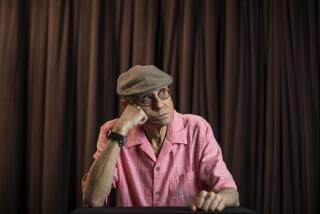A TAMED ‘KANGAROO’ PLAYS IT SAFE
- Share via
The movie that’s been made from D. H. Lawrence’s 1923 novel “Kangaroo” (Music Hall) is careful, admirable, quality work. Done by Australian director Tim Burstall and Jamaican screenwriter Evan Jones, it has beauty within and without--lovely landscapes and a compelling central couple, emigres Richard and Harriet Somers, who are modeled on Lawrence and his wife, Frieda.
Scenarist Jones does a good job of balancing two currents: the Somerses’ marriage and two opposing social forces gripping Australia in the 1920s--the socialist Trade Union movement and a fictional neo-fascist reaction, led by charismatic Ben (Kangaroo) Cooley and a legion of gung-ho army veterans. Yet all this reverence only underscores a major failure. It’s too safe a film, too embossed and careful. And if there’s one thing D. H. Lawrence should probably not be, it’s safe.
His prose was alive, fiery. He rarely let taste trammel him. He had an innate delicacy, but a horror of propriety. And “Kangaroo” is a movie that has tasteful labor riots, tasteful murders, even some tasteful seaside lovemaking. Lawrence’s words explode with rapture, but Burstall’s images rarely do. He doesn’t give you an equivalent for the book’s poetic landscapes, those “great gold bushes full of spring fire” and the “foam breaking blue as forget-me-nots or frost.” The novel itself seems more visual than the movie, whose poetry is mostly verbal.
Colin Friels, who plays Somers, is an excellent actor, but he suggests a somewhat warmer, more reasonable man than you want to see. There is one character here, though, who really does seem touched by Lawrencian fire and agony: Judy Davis’ Harriet, a tawny Teutonic tigress with flashing, deadly eyes. Her performance is the movie’s major triumph (it won her Australia’s equivalent of an Academy Award). She’s so superb that she begins to embody all those elements of sexuality and danger that seem missing elsewhere, that black, deep, absent vision.
The story’s anti-hero, Kangaroo Cooley, was another Lawrencian dark tempter. In the book, he’s Jewish--a vaguely anti-Semitic touch. In the movie he’s a more conventional Aussie Anglo-Saxon, an admirer of German militarism. As played by Hugh Keays-Byrne, the Toe Cutter in “Road Warrior,” he sometimes suggests a macho Nigel Bruce.
This bizarre character, a vigilante king babbling with love, almost seems to function as horrible wish fulfillment--Lawrence’s revenge for Somers’ and his own persecution by the British government and police during World War I. (The film begins with this episode--but Lawrence put it the novel’s center: a chapter called “The Nightmare” in which he poured a shocking, hideous fury.) Somers, persecuted by militarists, is pursued and swooned over by the paramilitarist Kangaroo. Rejected by the army, he gets to reject Kangaroo on his deathbed. It’s the ultimate triumph of Eros over Mars.
Evan Jones wrote two of Joseph Losey’s best films (“Eva,” “King and Country”) and apparently he cares about preserving Lawrence’s philosophy. It’s as if he were trying to convince us that Lawrence is a classic by staging him as you might stage Anthony Trollope or Arnold Bennett. The pauses are often interminable; you get the idea that the film makers could include everything they cut out of the novel--digressions and all--if only someone in addition to Judy Davis were picking up his/her cues.
This is a tamed “Kangaroo,” one that lies too peaceably on the shelf. Yet, despite it all, the movie still has something. The dark deeps and torrential emotion, the passions, the desperate reach and reckless ambition--they all retain such potency that this “Kangaroo” (MPAA-rated: R) can take hold, despite all your objections. If Davis’ performance were the rule here and not the exception, those strong, swift, underlying currents might still carry you away.
More to Read
Only good movies
Get the Indie Focus newsletter, Mark Olsen's weekly guide to the world of cinema.
You may occasionally receive promotional content from the Los Angeles Times.










